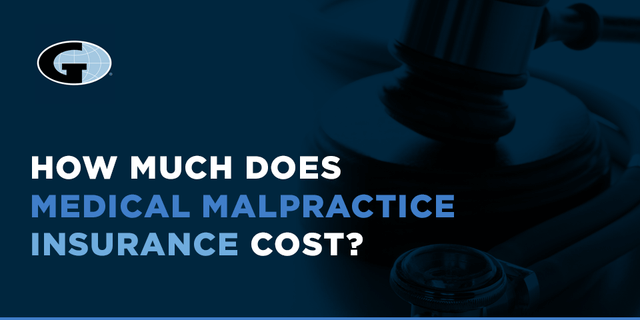
How Much Does Medical Malpractice Insurance Cost?
Gallagher Healthcare :: Industry Insights
By Gallagher Healthcare | 12/12/2017Updated on 3/19/2020

Medical malpractice insurance provides liability insurance for the risks medical professionals deal with day in and day out. Even if you have coverage offered by your employer because you work in a hospital or in a group practice that includes coverage, you should still have your own coverage. If you face a lawsuit that claims that you deviated from the standards of practice of your organization and therefore should pay compensation, malpractice insurance will encompass legal defense and possible settlement costs.
You may worry about how much doctor malpractice insurance costs. While it varies by state and changes from year to year, medical malpractice insurance cost is worth the investment for the protection it offers in uncertain situations. We put together this overview of factors contributing to medical malpractice insurance cost by state and how much you can expect to pay to help you make your decisions.
How Much Is Malpractice Insurance: The Statistics
Here are a few key statistics that affect the cost of medical malpractice:
- A study by John Hopkins shows that more than 250,000 deaths each year in the United States are attributable to medical error. Medical errors are the third leading cause of death in the United States.
- The cost of preventable harm is $19.5B annually, including additional medical expenses from mistakes.
- A report by the American Medical Association showed that 34 percent of doctors have had a claim filed against them while in practice. The chances of getting sued increase with age. Almost 50 percent of physicians over the age of 55 have been sued, while about 8 percent under the age of 40 have been sued.
- The average expense of a medical liability claim in 2015 was just above $54,000. That is a 64 percent increase over 10 years. However, in the same year, almost 70 percent of closed claims were dropped, only 7 percent of all claims were decided during a trial and of that 7 percent, defendants won more than 85 percent of those cases.
- Medical malpractice insurance varies greatly based on location and specialty. Insurance premiums for obstetricians/gynecologists in New York were as high as $215,000 in 2017 while in California they were just under $50,000.
- Male physicians are also more likely to be sued than female doctors. About 40 percent of male doctors have been sued during their careers while almost 23 percent of female doctors have been sued. Just over 20 percent of male doctors had more than one suit filed against them while just under 10 percent of female doctors were sued more than once.
Coverage can also affect medical malpractice insurance premiums. Doctors who want more coverage for multiple practices will pay more, as will physicians who need coverage across state lines. The malpractice insurance cost by specialty will also vary. Some specialties, such as orthopedic surgeries, are considered higher risk for insurance carriers, and premiums will reflect this.
Who Needs Medical Malpractice Insurance?
If you work in a health profession, including nursing, chances are you’ll need malpractice insurance. This includes:
- Any physician or surgeon who is currently in practice.
- Independent health professionals who work in facilities like hospitals or medical clinics, skin clinics, weight loss clinics, plastic surgery centers, chiropractors, HMOs, orthodontists and dentists.
How Has the Cost of Malpractice Insurance Changed Over the Years?
How much does medical malpractice insurance cost now vs. just a few years ago? The declining rate of medical malpractice claims has been linked to lower premiums. In 2001, there were 16,000 paid malpractice claims, according to TrueCostofHealthcare.org, and this number dropped to less than 8,500 by 2017, a decline of over 53 percent. From 2003 to 2017, the amount spent on claims fell by approximately 23 percent.

Different studies have reached different conclusions regarding the amount paid out on claims, though there's general agreement that the number of claims has gone down. A 2014 study by Brigham and Women’s Hospital in Boston found there was a decline between 2009 and 2014 in the number of claims made, though there was an increase in the amount of compensation paid out. The overall rate for claims against all doctors dropped by 55.7 percent, but the amount paid out in settlements increased by 23.3 percent, with neurosurgeons paying the most and dermatologists paying the least. The number of payments over $1M also increased.
Payouts for medical malpractice lawsuits amount to less than 1 percent of total healthcare costs. Oftentimes, defensive medicine, a related but different phenomenon, accounts for more added costs than malpractice insurance.
Summary of Cost for Medical Malpractice Insurance
A 2018 AMA report showed that while costs can be high depending upon specialty and location, over the last 10 years others have fluctuated greatly. In almost 75 percent of the categories requiring medical malpractice insurance, premiums stayed the same in 2017 as they were in 2016. Meanwhile, about 12 percent of other categories actually decreased from the following year.
Factors Affecting Medical Malpractice Costs
Many factors impact how much a physician will pay in medical malpractice premiums:
1. The State Where Physicians and Healthcare Professionals Practice
A medical practitioner in the same specialty and with the same experience will pay dramatically different premiums based on location. Part of this has to do with state laws. Different states have different tort laws. States have different regulations regarding limits on policies. Those requiring higher limits will result in higher premiums.
As well, each state has a different insurance climate. Those states with higher payouts may experience higher premiums, and those states with a more competitive insurance market may see more competitive rates. When wondering “how much does malpractice insurance cost?” doctors need to consider their location first. Even the county or city where a physician practices can impact annual premiums costs.
Malpractice insurance cost by state can vary greatly. A doctor in New York should expect to pay roughly six times as much for their malpractice insurance premiums as a doctor in California. The five states with the highest medical malpractice costs are:
The five states with the lowest medical malpractice costs are:
For instance, the per capita average yearly amount paid out in medical malpractice insurance claims against a New York physician was almost 15 times as much as was paid for a physician in North Dakota between 2012-2016. High payouts have been linked to high insurance costs.
Why does it cost so much more in New York? New York is one of many states that have not enacted any kind of tort reform, so there are no caps on economic or non-economic damages. As a result, medical malpractice insurance premiums are very high. Meanwhile, North Dakota has favorable tort laws and caps on non-economic damages, and if an economic damage award is over $250,000, it must undergo judicial review to determine if the award is appropriate.
2. The Physician's Field or Specialty

Malpractice premiums by specialty vary widely because some practices are higher risk. Specialties are divided and classified into no surgery specialties, minor surgery and surgery areas. Professionals in these last two areas are more likely to incur medical malpractice claims and generally see higher insurance costs. These specialties include:
- Neurosurgeons
- Obstetricians
- General surgeons
- Cardiovascular surgeons
- Plastic surgeons
- Orthopedic surgeons
- Emergency room doctors
The 2018 AMA report on liabilities premiums also provides a breakdown of how much malpractice insurance for physicians costs by specialty and how it differs from state to state. In obstetrics and gynecology during 2017:
- In Orange County, Los Angeles, a doctor in this specialty pays premiums of about $49,804 a year.
- Someone in this practice in Miami-Dade, Florida, on the other hand, faces a bill of about $190,829.
- In Philadelphia, insurance premiums would be about $119,446.
For a general surgeon during that same time frame:
- A general surgeon in Orange County, Los Angeles, pays a yearly premium of about $41,775.
- A general surgeon in Miami-Dade, Florida, would pay premiums of almost $190,829.
- A general surgeon in Philadelphia would pay $85,930.
On the other hand, someone who works in internal medicine in these locations would pay much smaller premiums. For instance, in Orange County, premiums for internal medicine cost $8,274. In Miami, they cost $47,707 and Philadelphia $24,873.
The specialties tend to experience claims with higher severity and frequency. Orthopedic surgeons perform procedures that rely on a number of factors, including patient fitness, patient response to anesthetics and so forth. Many unexpected events can occur during such a surgery, and recovery may not be guaranteed.
If surgery on a spine results in an undesirable result, the effects on a patient can be long-ranging and severe, leading to a claim for a larger amount.
These prices can fluctuate year to year based on factors like tort reform, the stock market, the number of doctors being sued and if a state has caps on things like non-economic damages.
3. Physician’s History With Claims and Losses
Most insurers will offer better premiums for physicians with no claims made against them, simply because such professionals present a lower claims risk. Physicians who have not had any claims against them in the past ten years will get the best rates. Those who have had multiple claims in that same period will pay more and may even find it challenging to get an insurance policy.
4. The Physician's Insurance Provider
Insurance providers in the same location will offer very different quotes, depending on their business model, overhead, application procedure and other factors. Physicians can work with an insurance advisor to compare quotes from different providers. In many cases, this will yield a range of possible insurance costs and can help doctors find the most competitive rates.
5. Hours Worked by the Physician
Longer hours mean more patients seen and more treatments offered, which means a higher possibility of an unfavorable result. Very long hours can also impact effectiveness and may be linked to unforeseen results. Tired, overworked doctors may be more at risk for errors. As a result, physicians working less than 20 hours a week can typically see some reduced costs for their premiums.
6. Competition Among Insurers
When there are multiple insurance carriers vying for a market share of a state’s market, they will sometimes apply to the state Department of Insurance to file for lower premium rates to become more competitive.
7. Tort Reform in the Physician's Home State
Tort reforms have been instituted in 33 states to address the growing costs of medical malpractice insurance and claims, especially since the 1990s. This influences the average cost of medical malpractice insurance by state. One area of tort reform that has received significant attention is non-economic damage caps in medical malpractice claims.
There are three main categories of damages that can be awarded in a medical malpractice suit:
- Economic damages are awarded to plaintiffs to compensate them for monetary losses suffered as a result of medical malpractice. This covers areas like lost wages and ongoing medical costs if those costs are shown to be connected to medical negligence.
- Non-economic damages in medical malpractice claims offer a dollar amount for the emotional distress, pain and suffering and other non-tangible damages suffered by a plaintiff in a malpractice claim. Placing a cap on this amount can limit how much patients can pursue for these damages. Historically, caps have reciprocal effects on medical malpractice costs.
- Punitive damages are only awarded in cases where there has been an egregious fault by a physician or healthcare professional. Punitive damages punish a healthcare professional that a judge or a jury feels deliberately acted in a detrimental matter. Punitive damages are rarely awarded and often limited by caps on awards. When a jury awards them, they are frequently adjusted by judges.
Once caps are overturned, medical malpractice costs tend to drop. However, states have differing results with this practice. Texas, Florida and Ohio all saw their medical malpractice costs decline after instituting caps. Louisiana and Massachusetts also have caps but continue to have high medical malpractice costs.
Not all tort reform laws have the same results. The states that have changed their tort laws changed them in different ways. For instance, some have more robust tort laws that place low caps on damages, while other states that instituted changes may still have high caps or only placed them on specific instances, such as wrongful death.

States with robust tort reform laws like West Virginia, Massachusetts or New Mexico still had high per-capita medical malpractice costs while states like Minnesota, Vermont and Alabama have low medical malpractice costs, even though they have never enacted tort reform. Alabama did pass some reforms, but the Alabama Supreme Court ruled that the changes were unconstitutional. The state still has a $1M cap on wrongful death suits.
Yet the question of whether tort reform has a dramatic impact on reducing medical malpractice costs, and thus the overall cost of healthcare, is still open since the cost of medical malpractice contributes only about 1 percent of the overall cost of medical care in the United States.
8. Policy Limits
Policy limits refer to the maximum amount an insurer will pay in the event of a claim. In medical malpractice insurance, the limit is split. For example, a $1,000,000/$3,000,000 limit will pay a maximum of $1M per claim and up to $3M for all claims during the policy term. The higher the policy limit, the more protection it offers and the larger the premiums.
9. Types of Insurance Providers
True insurance companies carry higher premiums but also offer greater financial stability and more robust policy provisions. Insurance trusts offer lower premiums but less financial stability and more limited policies. Both have a vital role to play in the medical malpractice marketplace, but the choice physicians make when selecting an insurance provider can have an impact on the premiums they pay.
10. Type of Coverage for Physician Malpractice Insurance Cost
Claims-made and Occurrence policies have different premiums.
- Occurrence policies, where available, are often preferred because they offer long-range coverage. If a physician pays for an occurrence policy and then ceases to pay that policy after a few years, they continue to be covered. If a claim occurs due to an event that took place while the physician was paying the policy, the physician is covered.
- On the other hand, claims-made policies only offer coverage as long as a physician keeps paying. Once the physician stops paying the insurance policy, any claims made are no longer covered unless the physician purchases an Extended Reporting Endorsement (also known as tail coverage) for 100 percent or more of the mature premium. No tail coverage is needed if a policyholder moves between insurance companies with claims made coverage.
11. Defensive Medicine
Defensive medicine has been one reaction in the medical community to increasing numbers of medical malpractice claims. A 2010 survey by Gallup found that 73 percent of physicians surveyed said they practice defensive medicine.
Physicians practicing defensive medicine may be ordering extra diagnosis tests, surgeries, treatments, prescriptions, referrals, hospitalizations and other options to avoid legal claims.
On the surface, this added diligence seems as though it should reduce malpractice claims by helping physicians notice and address any health concerns. However, defensive medicine can increase premiums. More medical treatment can mean more hours worked, which can mean larger premiums. In addition, each treatment or surgery can potentially increase risks, which can lead to increased claims history and then to increased insurance costs.

The true cost of defensive medicine, however, is hard to pin down. While a 2010 study says that it costs about $45.6B a year, other studies argue that true defensive measures actually cost much less and defensive decisions only account for about 2.9 percent of overall healthcare spending. That report argues that while doctors may make a decision partially based on defensive medicine, there are other factors involved.
12. Variances in Practices
A physician who works across state lines, offers services in multiple facilities or has other unique characteristics may find their premiums affected by these factors. Each medical practitioner and facility is different, which is why such a range of insurance costs exists.
When speaking of the average cost of malpractice insurance, then, we can see that many factors can impact how much a doctor will pay for malpractice insurance. The cost of medical malpractice insurance by state, by specialty and by other factors will vary. When considering the average cost for malpractice insurance or when asking “How much does a doctor pay for malpractice insurance?” what most professionals are asking is “How much must I pay?”
If you are a medical professional in need of professional liability coverage, it can be useful to get a general sense of possible costs by examining the average cost of medical malpractice insurance by specialty and by looking at medical malpractice insurance rates by state. Ultimately, you will want to get a quote since your own costs may be very different than the average and may be significantly lower than the highest malpractice insurance premiums paid in your area.
In addition to the most common factors impacting premiums, there are many potential elements that could impact future costs for medical professionals. For example, some have suggested medical reforms to reduce instances of negative medical outcomes, thus reducing the number of incidents that can lead to medical malpractice claims. Some have suggested insurance reforms to impact how often insurers can increase premium rates.
Why Do Medical Malpractice Premiums Fluctuate?
Competition or lack of competition between malpractice insurance companies can affect malpractice insurance premiums. When a state has many carriers, competition can reduce costs. When companies consolidate operations, this can cause prices to eventually rise as competition decreases. On the other hand, when new companies emerge, this can create additional competition, and carriers may be pushed to offer lower premiums to compete.
The stock market impacts premiums as well by impacting insurance industry economics. Most companies in the insurance industry invest in the stock market to create profits. When the stock market drops, premiums increase as companies need to cover losses. Between 1998 through 2001, insurers experienced financial losses because interest rates on bonds fell and about 80 percent of insurers’ portfolios involved bonds.
During this same time period, competition in the market led some insurers to cover very competitive rates that ultimately did not cover their losses. As a result, some left the medical malpractice practice area while others become insolvent due to these market factors.
When insurers experience losses on claims, they also increase premiums.
One issue that impacts medical malpractice insurance providers is the comparatively longer time it can take to resolve medical malpractice claims. While the stock market can change almost overnight, medical malpractice cases can take years to settle. This can make the fluctuations in the malpractice market more significant.
In addition, as healthcare groups become consolidated and become large entities in their own right, some have chosen to exit the traditional insurance market and insure themselves or seek alternatives. This can have a significant impact on the insurance market and can affect how competitive insurers remain, placing additional pressure on remaining insurers to compete for existing clients.
Many people think premiums have to do with malpractice case verdicts, but the costs physicians pay for insurance has more to do with investments. Companies invest the premiums they collect, and whether insurers make or lose money on these investments has a greater impact on premium rates.
Who Pays for Malpractice Insurance?
If you are a medical professional, you will need medical malpractice insurance. Your hospital or clinic may provide you with coverage. If you own a healthcare facility, you need to pay for medical malpractice insurance for your entity, your employees and yourself. Who pays for coverage depends on your employment situation.
If you own a clinic or any healthcare entity, you are liable for the actions of your employees, and your entity may be vulnerable in case of any claim. You can also choose to require your employees maintain their own assets. If you have a solo practice, you will be able to share policy limits with entity coverage. If you are part of a healthcare group, the insureds in the group will generally have to pay insurance and the entity will also need to be covered.
Some employees, such as nurse practitioners, midwives and other professionals may need to pay an extra premium to secure individual coverage.
When looking at the average cost of medical malpractice insurance for doctors by state and other averages, consider who will pay for insurance and what the insurance will cover. An individual in a solo practice will be paying much different rates than an entity covering multiple employees.

Are You Wondering About Medical Malpractice Insurance Costs?
Chances are, you are not thinking about “how much do doctors pay for malpractice insurance?” and more considering how to keep your own costs in check. If you are considering how much you may have to pay for medical malpractice insurance costs, contact Gallagher Healthcare to find out how much you could save on premiums, learn more about our medical malpractice insurance, and request a quote.